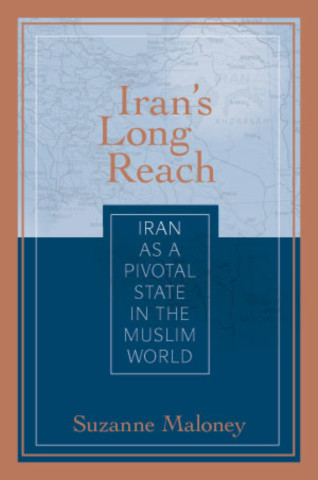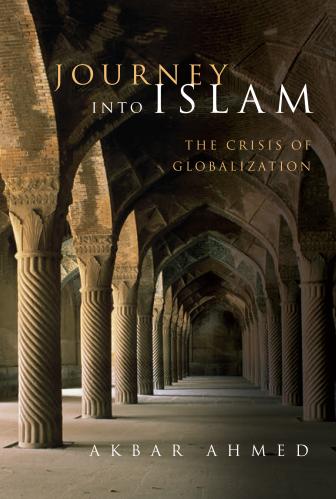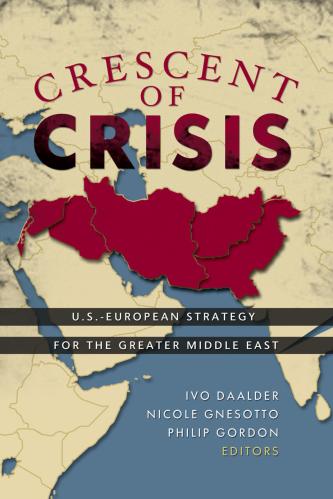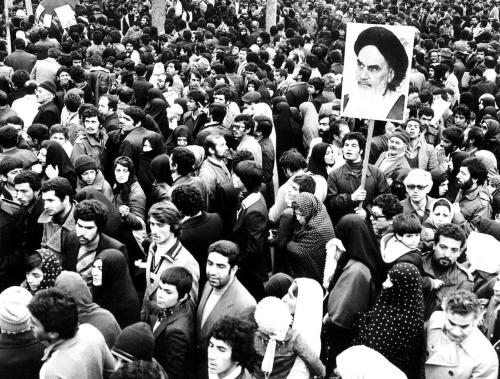Iran’s revolution has inspired countless books, articles, films, and commentary. On the 40th anniversary of that momentous event, we’ve compiled some recommendations on further reading for anyone interested in a deeper understanding of the establishment of the Islamic Republic and its legacy.
1Shaul Bakhash, “The Reign of the Ayatollahs: Iran and the Islamic Revolution”
Journalism is often said to be to be first draft of history. This is especially true when the journalist also happens to be a distinguished historian. Bakhash brings his keen eye for narrative and detail from his time as editor and news analyst for Keyhan newspaper prior to the revolution as well as the context of his deep expertise in Iran’s history. Few books written in the immediate aftermath of epic events can stand the test of time. “The Reign of the Ayatollahs” is a notable exception.
2Darioush Bayandor, “The Shah, the Islamic Revolution and the United States”
Meticulous and comprehensive, this newly released study of the 1979 revolution is a very worthy addition to an already copious literature on Iran. With the distance of history and expanding archival access that offers new insights into American efforts to engage with Ayatollah Khomeini on the eve of the monarchy’s collapse, Bayandor provides a gripping chronicle of the forces that gave rise to a populist revolution and a theocratic post-revolutionary government.
3David Burnett, “44 Days: Iran and the Remaking of the World”
It’s impossible to understand the Iranian revolution without visuals, and this book offers a stunning portrayal of the Iranian Revolution through the lens of an American photo-journalist who was in Iran at the time the revolution began to take root. The book documents the revolution through photos that capture the chaos and drama of Iran in 1978-79. Burnett includes several eyewitness accounts describing the last days of the Iranian monarchy and the first days of Khomeini’s rule. See some of the photos included in the book here.
4Peter Chelkowski and Hamid Dabashi, “Staging a Revolution: The Art of Persuasion in the Islamic Republic of Iran”
Imagery played a crucial role in helping to galvanize the mobilization against the shah, and Chelkowski and Dabashi explain how the revolution built upon an ideological reconfiguration and how symbolism was deployed to mobilize opposition to the shah and define the new era. The book’s vivid reproduction of the artworks of the revolution—posters, paintings, murals, cartoons, leaflets, movies, even banknotes and stamps—might lead the reader to presume this is merely a magnificent coffee table book, except that the images are accompanied by detailed text that is equally rich with analysis and informed commentary.
5Andrew Scott Cooper, “The Fall of Heaven: The Pahlavis and the Final Days of Imperial Iran”
In writing this book, Cooper benefitted from cooperation with Farah Pahlavi, the queen who was especially influential during the final years of the monarchy. So it comes as no surprise that the end result is a much more sympathetic interpretation of the shah than mainstream literature has offered to date. And yet his intimate portrayal of the royal family’s life within the palace walls as their world crumbled around them remains well worth the read. (Pair this with the front row seat provided by Gholamreza Afkhami’s masterful biography of the shah, or the judicious perspective offered by Abbas Milani’s account.)
6Oriana Fallaci, “The Shah of Iran: An Interview with Mohammad Reza Pahlevi,” published in The New Republic, December 1, 1973; “An Interview with Khomeini,” published in The New York Times, October 7, 1979; “Everybody Wants to Be Boss,” published in The New York Times, October 28, 1979.
Italian journalist Orianna Fallaci lived an exceptionally colorful life, in which her pioneering work as a political correspondent unfortunately became overshadowed by the anti-Muslim polemics she wrote in her later years. But at the height of her career, Fallaci utilized her devastating capacity as an interviewer in grilling some of the world’s most powerful leaders. A trio of conversations with key Iranians—the shah, Ayatollah Khomeini, and Iran’s first post-revolutionary prime minister Mehdi Bazargan—make for captivating and informative reads.
7Joseph Kraft, “Letter from Tehran,” published in The New Yorker, December 18, 1978.
Kraft was said to be a confidante of the Iranian establishment, hardly an unusual status since the Pahlavi elite openly courted opinion makers in the West. His first-hand account of his conversations with a wide range of Iranians—the shah, opposition leaders, influential clerics, academics, and government officials—just as the maelstrom of the revolution overtook the monarchy is poignant both for its prescience and its misplaced expectations. The piece concludes with the expectation of compromise along with the caveat that “the moment is not going to last very long.”
8Charles Kurzman, “The Unthinkable Revolution in Iran”
The Iranian revolution has confounded experts from a variety of disciplines and backgrounds. What precipitated the revolution and what enabled this movement to succeed where so many others have failed? Kurzman, a sociologist who has conducted research in Iran and among Iranian emigres, examines the traditional theories around revolutions, which in turn emphasize economic, political, cultural, organizational, and military factors, and finds no single explanation sufficient. Instead, he concludes: “So long as revolution remained ‘unthinkable,’ it remained undoable. It could come to pass only when large numbers of people began to ‘think the unthinkable.’”
9Abbas Milani, “The Persian Sphinx: Amir Abbas Hoveyda and the Riddle of the Iranian Revolution”
This is not strictly a book about the revolution, but it begins and concludes in the prisons of the nascent theocracy, where the man who had served the monarchy as prime minister for nearly 13 years spent his final days. In compelling fashion, Milani recounts Hoveyda’s life in the service of the shah—who nonetheless detained him in hopes of assuaging public anger as the revolution reached its frenzied peak—and his death at the hands of the revolution’s infamous tribunals, where his final words were “It wasn’t supposed to end like this.”
10Roy Mottahedeh, “The Mantle of the Prophet: Religion and Politics in Iran”
As Suzanne wrote almost a decade ago, “Iran scholars are a fractious bunch, but one book commands nearly universal respect. Roy Mottahedeh’s The Mantle of the Prophet, they agree, offers an unparalleled perspective on the revolution and its antecedents as seen through the eyes of an archetypical cleric.” In this work of historical fiction, Mottahedeh elegantly threads together the historical and cultural antecedents that shaped the revolution.
11Azar Nafisi, “Reading Lolita in Tehran: A Memoir in Books”
In this tour de force, Azar Nafisi invites the reader into her home for an intimate look into the psychosocial fallout of the revolution through the eyes of Iranian women. Nafisi illustrates the harrowing ways daily lives were altered during the Iranian cultural revolution. The memoir follows a reading group she held at her home for seven of her former students and the parallels they drew between great works of literature and their own experiences, including being beaten and incarcerated for sins like “bad hijab.” From the first major protest of the post-revolutionary era to today’s social media campaigns, Iranian women have played crucial roles in contesting Iran’s revolution, and this book provides key insights for understanding how and why.
12Nate Penn, “444 Days in the Dark: An Oral History of the Iran Hostage Crisis,” published in GQ, November 3, 2009.
For many in the United States and elsewhere around the world, the foremost memories of Iran’s revolution transpired six months in its aftermath, with the November 1979 seizure of the U.S. embassy in Tehran by a radical student group. The 444-day standoff that followed completed the bitter rupture of the bilateral relationship, facilitated the clerics’ consolidation of control over the post-revolutionary order, torpedoed President Carter’s reelection prospects, and left an enduring legacy of the Islamic Republic’s spurning international norms and law. This GQ article draws on interviews with over 50 Americans and Iranians who were in some way involved with or impacted by the siege, including former hostages, their captors, government officials and experts. If you come away eager for more details on the U.S. response, there is no better resource than “American Hostages in Iran: The Conduct of a Crisis,” by Warren Christopher, et al.
13Marjane Satrapi, “Persepolis: The Story of a Childhood”
This graphic novel features stark black-and-white drawings and sharp dialogue, as Marjane Satrapi draws on her personal experiences growing up in Iran during the revolution to detail its immediate impact on the daily lives of ordinary Iranians. Satrapi gives us the view of these historic events from the perspective of a rebellious young girl. Satrapi’s two “Persepolis” novels were eventually translated into a popular film.
14Gary Sick, “All Fall Down: America’s Tragic Encounter with Iran”
For an episode that had such dramatic impact on U.S. politics and security, there are relatively few thorough accounts of how the U.S. government approached the crisis as it unfolded. (Robert Jervis’ “Why Intelligence Fails” convincingly addresses one dimension of the puzzle.) From his vantage as chief National Security Council official on Iran during the revolution and the hostage crisis, Sick provides a dispassionate play-by-play of the policy process within the Carter administration during this tumultuous period.
15Theda Skocpol, “Rentier State and Shi’a Society in the Iranian Revolution,” Theory and Society 11:3 (May 1982), pp. 265-83.
Renowned political scientist Theda Skocpol is the author of, among many other works, an authoritative tome on social revolutions. The book focused on the structural causes of revolutions, arguing that international pressures exacerbate state weaknesses and produce new strains on the regime’s agricultural base, thus provoking peasant uprisings. Revolutions are not made, she asserts—they come. Unfortunately, its original publication coincided with the Iranian revolution, whose patterns directly contradicted Skocpol’s arguments. In this piece, she addresses the challenges to her broader theory of revolutions and highlights Iran’s rentier economy and the symbolic and organizational opportunities afforded by Shiite Islam as distinguishing factors.








Commentary
What to read to understand the 1979 Iranian revolution
January 28, 2019